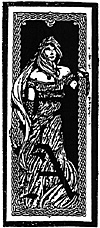 One of the most asked questions in any role-playing games has got to be "What do
we see?", and any GM worth his weight in dice should not hesitate to answer whether in a
descriptive fashion or in a plain tone just what the players see. Part of the GM's responsibility is to provide the player's with an absolute picture of their surroundings as their characters see them. If done properly, it adds a more realistic sense of being an active part of the game's story in which the player characters are the major part of
One of the most asked questions in any role-playing games has got to be "What do
we see?", and any GM worth his weight in dice should not hesitate to answer whether in a
descriptive fashion or in a plain tone just what the players see. Part of the GM's responsibility is to provide the player's with an absolute picture of their surroundings as their characters see them. If done properly, it adds a more realistic sense of being an active part of the game's story in which the player characters are the major part of
Describing every scene in detail may be an endless task but it is not a thankless one by far. When giving a description of a scene you allow the player's a wider selection of choices which can improve their overall actions or decisions in any given situation. For example, when entering a small bugbear barracks, the PCs would see the following scene:
"As your fighter creeps into the room he stumbles onto four large dark hairy humanoid creatures with squashed faces and beady eyes. They look up for a glance at your over their flagons and plates that rest on a large wooden table they are seated at. With a chuckle one of the monsters rises to its full six feet of height and advances towards you and raise a knife while saying "MMMMM-me thinks you taste more better than damn rats, me see now!"
With the with the above description the player can envision just what he is up against and also how he can use the area to his advantage. He can do an even wider array of actions ranging from a straight up toe to toe fight to a jump on the table in swash buckle style battle. As the GM you have set the stage, now the outcome is up to the actions of the players themselves.
Back to White Knight #10 Table of Contents
Back to White Knight List of Issues
Back to Master Magazine List
© Copyright 1998 by Pegasus-Unicorn Productions
This article appears in MagWeb (Magazine Web) on the Internet World Wide Web.
Other military history articles and gaming articles are available at http://www.magweb.com